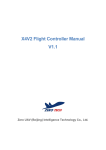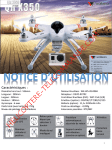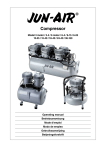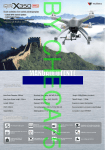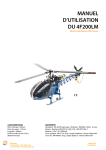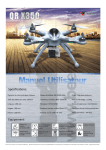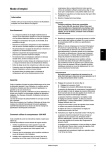Download Walkera Master cp Specifications
Transcript
Specifications: Main Rotor Dia. : 462mm Standard transmitter: DEVO-7E Tail Motor: 1627F Tail Rotor Dia. : 113mm Optional transmitter: DEVO-6/7/8S/10/12S Main Motor: 380PF Overall Length: 440mm Receiver: RX2637H-D Recommend Environment: Indoor and Outdoor All-up Weight: 420g (Battery included) Gyro: 6-Axis Recommend Experience Level: Intermediate Level Battery: 11.1V 1000mAh Li-Po Brush ESC: Master CP ESC Product type: 200 size Collective Pitch Enter level helicopter Servo: WK-7.6-6 / weight 8.5g / speed 0.09sec/60°(4.8V) / torque 0.9kg/cm (4.8V) / dimension 22.5×11.8×24mm Features: 1) Latest 6-Axis stability enhance Control system ensures stable and precise flight , it is easy to control for both basic flight and 3D flight, 100% decrease the difficulty of the operation. 2) High performance Brushed motor not only reduce the cost,but also ensures enough powerful to do 3D as the brushless motor. 3) Adopts 2.4 GHz technology and supports both fixed and automatic ID binding and ID assignment. 4) The RX firmware can Update Online (required UP02 upgrade cable and adapter ). 5) Telemetry function can be accomplished after update the RX firmware. The Telemetry helps you get a real time data feedback about the Battery Voltage and the Motor Temperature .(A telemetry function Radio is a must) Contents 01. Forewords 1 08. Servo setup and adjustment 12 02. Safety matters needing attention 1 8.1 Specification and function of servo 12 2.1 Important Statement 1 2.2 Safety matters needing attention 1 8.1.1 Specification of servo 12 8.1.2 Basic function of servo 12 (1) Far away from obstacles and people 1 (2) Keep away from humidity 1 (3) Proper operation and maintenance 1 8.2.1 Connection of servos 12 (4) Avoid flying alone 1 8.2.2 Adjustment of servos 12 (5) Safe operation 2 8.2.3 Matters needing attention 12 (6) Keep away from high-speed rotating parts 2 (7) Protect from heat 2 8.2 Connection and adjustment of servos 09. Instruction and attention of GA005 balance charger 2.3 Attention before flight 03. Definition of Helicopter Orientation 12 13 2 9.1 Parameters of GA005 balance charger 13 9.2 Features of GA005 balance charger 13 3 04. Standard equipments 3 9.3 Instruction of GA005 balance charger 13 05. Transmitter setup 4 9.4 Operation steps 13 5.1 DEVO-7E(standard radio) setting 4 9.5 Charging status corresponding to LED 14 5.2 DEVO-6/7/8S/10/12S(optional radio) settings 6 9.6 Matters needing attention 14 06. Setup of the RX2637H-D receiver 8 9.7 Maintenance of battery pack 14 6.1 RX2637H-D receiver features 8 10. Steps of flight 15 6.2 Function of receiver 8 10.1 Installation of battery 15 6.3 Channel connection of receiver 9 10.2 Turn on the power 15 6.4 Testing Mode setting 9 6.5 Adjustment of receiver 10 6.6 Matters needing attention 10 10.2.1 Turn on the power 15 10.2.2 Matters needing attention 15 10.2.3 Trouble shooting a flashing receiver LED after connecting the power cable 16 07. Instruction and attention of ESC 11 7.1 Function of brush ESC 11 7.2 Connection method of brush ESC 11 10.3.1 Adjustment of swashplate 16 7.3 Matters needing attention 11 10.4 Adjustment of main rotor blades 17 10.3 Adjustment before flight 16 10.4.1 Color decal (tracking tape) 17 10.4.2 Inspection and gravity center adjustment of main rotor blades 17 10.4.3 Tracking inspection 17 10.4.4 Adjustment of blade tracking 18 11. Flight over 18 Appendix 1-Flight control 19 Appendix 2 – Flight practice 20 1 Flight practice for the beginner 20 1.1Matters needing attention 20 1.2 Steps 20 2 Advanced practice 21 2.1 Frog-hopping practice 21 2.2 Controlled take off and landing practice 21 2.3 Square flight practice 21 2.4 Figure eight practice 21 2.5 Aerobatic flight 22 Dear customer: Thank you for purchasing a Walkera radio control aircraft product. In order to quickly and safely master the operation of the Master CP RC helicopter, please read the user handbook carefully and then keep it in a safe place for future consultation and reference. Master CP with spread spectrum technology features impressive power, stable flight, immediate response and strong anti-jamming characteristics. 01 2.1 Important Statement Forewords (1) This product is not a toy. It is a piece of complicated equipment which harmoniously integrates engineering materials, mechanics, electronics, aerodynamic and high frequency radio. Correct installation and adjustment are necessary to avoid accidents taking place. The owner must always operate in a safe manner. Improper operation may result in serious property damage, bodily injury or even death. (2) We accept no liability for damage and consequent damage arising from the use of these products, as we have no control over the way they are maintained, used and operated. (3) This product is suitable for experienced RC Helicopter pilots aged 14 years or more.All minors must be accompanied by a responsible adult when flying. (4) The flight field should be legally approved by the local government. We accept no liability for any safety duties or fines arising from operation, usage or mis-control after the sale of the products . (5) We consign our distributors to offer technical support and service after sale. Please contact the local distributors for problem resolution caused by usage, operation, maintenance, etc. 2.2 Safety matters needing attention 02 Safety matters needing attention RC helicopter flight is a high risk hobby, whose flight should be kept far away from other people. Mis-assembled or broken main frame, defective electronic equipment, and/or problematic radio system will lead to unforeseen accidents such as bodily injury or property damage. The pilot MUST pay attention to the flight safety and UNDERSTAND his responsibility for accidents caused by his carelessness. (1) Far away from obstacles and people An RC helicopter in flight has risk of uncertain flight speed and direction which is potentially dangerous. When flying, please keep your RC helicopter far away from people, high buildings, high-tension lines, etc, and avoid operating in rain, storms, thunder and lightening. (2) Keep away from humidity RC helicopter should be kept away from humidity and vapor because its complex,precise electronic components and mechanical parts may be damaged. (3) Proper operation and maintenance Please use Walkera original spare parts to upgrade, modify or maintain your helicopter in order to ensure its safety. Please operate your helicopter within the range of functions permitted. It is forbidden to use it outside of the safety laws or regulations. (4) Avoid flying alone At the beginning of learning about radio-controlled flight there are some difficulties to overcome. Please avoid flying alone. Invite experienced pilots to guide you (two of the most effective methods to practice are via a PC flight simulator and/or under the supervision of a skilled pilot). 1 (5) Safe operation Please fly your helicopter according to your physical status and flight skills. Fatigue, listlessness and mis-operation will increase the possibilities of accidental hazard. (6) Keep away from high-speed rotating parts Please keep the spinning blades of both main rotor and tail rotor away from the pilot, people and other objects. (7) Protect from heat An RC helicopter is made from metal, fiber, plastic and electronic components, etc. Please keep away from heat and sunshine in order to avoid distortion, even damage, caused by high temperatures. 2.3 Attention before flight (1) Ensure the battery packs of both transmitter and receiver are fully charged (saturated). (2) Ensure both the throttle stick and the throttle trim of your transmitter stay at the lowest positions before operation. (3) Please strictly obey the order of turn-on and turn-off before operation. When starting your flight, please turn on your transmitter first, and connect the power cable of your helicopter last. When finishing your flight, please disconnect the power cable of your helicopter first, and turn off your transmitter last. (4) An upset in the order of connection may cause your helicopter to loose control. Please cultivate a correct habit of turn-on and turn-off. (5) Ensure the directions and actions which servos execute transmitter commands are correct and smooth, respectively. Using a broken servo will result in unforeseen dangers. (6) Check there are no missing or loose screws and nuts, no unassembled or damaged parts. Carefully check the main blades have no defects, especially the position close to the main blade connector. Broken or unassembled parts will have an effect on the flight performance, and will cause unforeseen potential dangers. (7) Check all the connections between ball linkage and ball. Loose linkages and balls should be changed. Loose connection between linkage and ball will have an effect on the flight performance, even lose control. (8) Assure there are solid connections between the power cables of battery pack and motors. Continuous vibrations in flight may loosen the battery tie-ins. 2 02 Safety matters needing attention In order to avoid confusion, the following sections will use the directions and orientations defined as follows.The helicopter is in front of the pilot with the tail boom and rotor closest to the pilot (tail in), the head or nose is facing forward (pointing away from the pilot).The left hand of the pilot is to the left side of the helicopter, the right hand of the pilot is to the right side of the helicopter.Its head/nose is to the front and it's tail boom is to the back. The direction in which the main body is facing is defined as up and its skids are in the down direction, as shown in the diagram below. up right 03 Definition of Helicopter Orientation front back left down Helicopter Transmitter 04 Standard Li-polymer battery pack Tool kit equipments Wall adapter /Power supply User Handbook GA005 balance charger PIT Gauge 3 5.1 DEVO-7E(standard radio) setting 5.1.1 Boost Screen Elevator trim Throttle trim Transmission power display Battery charge indicator Model name Transmitter Timer display Model type display Throttle percentage value Rudder trim display Aileron trim display 5.1.2 Type Select Press ENT to get Main Menu and press UP or DN to select Model Menu. Press ENT to enter and press UP or DN to select Type Select and press ENT to enter setting interface.Press R or L to get the icon of Helicopter and press ENT to confirm, then press EXT to exit. 5.1.3 Model Select Press UP or DN to select Model select in Model Menu, press ENT to get the Model Select setting interface; press UP or DN to select MOD 1, then press ENT to confirm and then press EXT to exit. 5.1.2 Type Select 5.1.3 Model Select 5.1.4 Model Name Press UP or DN to select Model Name in Model Menu, press ENT to get the Model Name setting interface. Press UP or DN to select the character and figure which are needed to be changed, press R or L to change character and named "MASTERCP". press EXT to exit after finished. 5.1.5 Swash Type Press UP or DN to choose SWASH in Model Menu, press ENT enter to Swash setting interface. press UP or DN to choose 1 Servo Normal, and press ENT to confirm and then press EXT to exit. 5.1.4 Model Name 5.1.5 Swash Type 5.1.6 Device Output Press UP or DN to select Output Device in Model Menu and press ENT to enter Output Device interface;press UP or DN to select "HOLD SW" "Activate", and "FMOD SW" "Gyro". Press ENT to confirm and then press EXT to exit. 4 05 setup 5.1.7 Reverse Switch 05 Press UP or DN to select Function Menu in Mian Menu, press UP or DN to choose Reverse Switch and press ENT to enter into Reverse Switch interface;press UP or DN to choose channel, press R or L to shift the status between normal and reverse.and press ENT to confrim and then press EXT to exit. Transmitter Channel setup Status Elevator Aileron Throttle Rudder Gear Pitch Gyro Normal Normal Normal Normal Normal Normal Normal 5.1.8 Throttle Curve Press UP or DN to select Throttle Curve in Function Menu, press ENT, the enquiry dropdown is shown "All servos hold?" press R or L to choose Cancel, and press ENT to confirm. There are total two flight modes: Normal Flight, Stunt, and the flight mode can be shifted by FMOD. Press DN , you can shoose On or Off, press R/L to choose On. Press DN, there will interface of Curve Point, choose L M H by press R/L. press DN, there will be Output Setting. press R/L to choose the value of point, and press ENT to confirm and then press EXT to exit. point Flight mode output Normal Flight Stunt L M H 50.0% 100.0% 100.0% 75.0% 100.0% 0.0% 5.1.9 Pitch Curve Press UP or DN to select Pitch Curve in Function Menu, press ENT, the enquiry dropdown is shown "All servos hold?" press R or L to choose Cancel, and press ENT to confirm. There are total two flight modes: Normal Flight, Stunt, and the flight mode can be shifted by FMOD. Press DN , you can shoose On or Off, press R/L to choose On. 5 Press DN, there will interface of Curve Point, choose L M H by press R/L. press DN, there will be Output Setting. Press R/L to choose the value of point, and press ENT to confirm and then press EXT to exit. 05 Transmitter point Flight mode output L M H Normal Flight -15% +25% +55% Stunt -55% +0% +55% 5.1.10 Gyro Sensor Press UP/DN to choose Gyro Sensor in Functional Menu, then press ENT into Gyro Sensor interface, press R or L to choose Manual Setting; press DN, SWITCH will be shown, press R or L to choose HOLD SW; press DN, "Pos 0" will be show first, and press R/L to increase/decrase value individually. Press DN "Pos 1" will be show after finishing "Pos 0". and press ENT to confirm and then press EXT to exit. Mode Manual Switch HOLD SW Pos 0 75.0% Pos 1 50.0% 5.2 DEVO-6/7/8S/10/12S(optional radio) settings 5.2.1 Type:Helicopter 5.2.2 Swash type:1 Servo Normal 5.2.3 Device Output DEVO-6 DEVO-7 Gear GEAR SW Gyro GEAR GEAR ACT Pitch System Active AUX2 AUX2 GYRO DEVO-10 DEVO-12S Gear GEAR SW Active AUX2 FMOD SW Gyro AUX3 RUDD D/R Active AUX4 AUX4 KB Active AUX5 AUX5 KB Active 6 DEVO-8S Gear Pitch GEAR SW System Active Active AUX2 AUX2 Lever Gyro AUX3 AUX3 Lever Active AUX4 AUX4 Lever Active AUX5 AUX5 Lever Active AUX6 AUX6 Knob Active AUX7 AUX7 Knob Active Gear GEAR SW Active Pitch System Active AUX2 FMOD SW Gyro AUX3 RUDD D/R Active setup 5.2.4 Reverse switch settings DEVO-6 05 Transmitter setup DEVO-7 DEVO-8S Elevator Normal ELEV NORM Elevator Normal Aileron Normal AILE NORM Aileron Normal Throttle Normal THRO NORM Throttle Normal Rudder Normal RUDD NORM Rudder Normal Gyro Normal GEAR NORM Gear Normal Pitch Normal PITCH NORM Pitch Normal GRYO NORM Gyro Normal AUX3 Normal DEVO-10 DEVO-12S Elevator Normal Aileron Normal Throttle Normal Rudder Normal Gear Normal Pitch Normal Gyro Normal AUX3 Normal AUX4 Normal AUX5 Normal Elevator Aileron Throttle Rudder Gear Pitch Normal Normal Normal Normal Normal Normal Gyro AUX3 Normal Normal AUX4 Normal AUX5 AUX6 AUX7 Normal Normal Normal 5.2.5 Throttle curve point Flight mode L output M H Normal Flight 0.0% 50.0% 100.0% Stunt 1 100.0% 75.0% 100.0% Stunt 2 100.0% 75.0% 100.0% 5.2.6 Pitch curve point L M H Normal Flight -15% +25% +55% Stunt 1 -55% 0% +55% Stunt 2 -55% 0% +55% Flight mode output 5.2.6 Gyro sensor Mode Manual Switch MIX SW Pos 0 75.0% Pos 1 70.0% Pos 2 50.0% 7 6.1 RX2637H-D receiver features (1) Adopts 2.4G DSSS technology with the functions of automatic scanning, code binding and LED receiving indication. (2) The use of a high performance receiver dramatically reduces the possibility of signal loss and ensures the accuracy and reliability of signal reception. (3) makes fine actions and powerful functions available. (4) Controlled by 6-axis gyro,with flybarless balance electronic system, amend flight status automatically, makes more stable flight and flexible 3D performance. 06 Setup of the RX2637H-D receiver 6.2 Functions of receiver S/N Name for short Full name Function Connects to the elevator servo and receives the control signal of elevator servo. 1 ELEV Elevator servo 2 AILE Aileron servo Connects to the aileron servo and receives the control signal of aileron servo. 3 PIT Pitch servo Connects to the PIT servo and receives the control signal of PIT servo. 4 Not used Not used Not used 5 THRO Throttle Connects to the main motor signal wire of ESC, and receive the control signal of main motor. 6 Not used Not used Not used 7 POWER CHECK Power check Connects to Power check signal wire of ESC. 8 SPARE Spare chanel Spare chanel(After receiver upgrade to the programe with telemetry function, it can connect to the temperature sensor to monitor the motor temperature. 9 TAIL MOT Tail motor Connects to tail motor signal wire of ESC, receive control signal of tail motor. 10 ELEV G.S Elevator gyro sensitivity adjust dial Adjusts the Elevator gyro sensitivity gain, changes the flight effect. 11 AILE G.S Aileron gyro sensitivity adjust dial Adjusts the Aileron gyro sensitivity gain, changes the flight effect. 12 ELEV/AILE EXT. extent dial Elevator/Aileron servo 8 Adjusts Elevator/Aileron servo Travel. 6.3 Channel connection of receiver AILE 06 ELEV PIT Setup of the RX2637H-D receiver 9 ELEV The white wire is facing front. AILE The white wire is facing front. PIT The white wire is facing front. Not used Not used. THRO Connects to the main motor signal wire of ESC. The white wire is facing front. Not used Not used. POWER CHECK Connects to Power check signal wire of ESC. SPARE After receiver upgrade to the programe with telemetry function, connect to the temperature sensor. TAIL MOT Connects to tail motor signal wire of ESC. The red wire is facing front. The Orange wire is facing front. 6.4 Testing Mode setting Note: When mounting the receiver, please make sure the receiver is placed flat and perpendicular to the main axis of the helicopter main rotor. (1) Standard Transmitter: DEVO-7E After code pairing successfully, Switch HOLD to position 1 and make sure the gyro setting position 1 Value *50.0%. Meanwhile the LED indicator starts to flash slowly, it enters into testing mode. You can adjust the swashplate to horizontal level by adjusting the servos or mechanism or PIT adjustment. Switch HOLD to position 0 to enter flight mode after the adjustment finished. Flight is prohibited under testing mode. HOLD SW MIX SW (2) DEVO-6/7/8S/10/12S Transmitter selectable After code pairing successfully, Switch MIX to position 2 and make sure the gyro setting position 2 Value *50.0%. Meanwhile the LED indicator starts to flash slowly, it enters into testing mode. You can adjust the swashplate to horizontal level by adjusting the servos or mechanism or PIT adjustment. Switch MIX to position 0 to enter flight mode after the adjustment finished. Flight is prohibited under testing mode. 9 6.5 Adjustment of receiver (1) Status of LED indicator of receiver: quick flash means the signal is being received; solid lighting means the signal has been received; slow flash means no signal has been received. (2) Gyro turning knob: CW rotating towards (+) increases the gyro sensitivity and CCW rotating towards (-) decreases the gyro sensitivity. (3) Servo extent knob: CW rotating towards (+) increases the servo travel and CCW rotating towards (-) decreases the travel. 06 (4) Receiver fixed ID cancellation: Insert the supplied BIND PLUG into the ELEV channel in the receiver, and then power on the receiver. The red light of receiver will flash slowly. This means the fixed ID code has been cancelled. Remove the BIND PLUG. Setup of the (5) Receiver upgrade: RX2637H-D (5.1) Master CP control program upgrade can be downloaded online at Walkera Offical Website:www.walkera.com. receiver (5.2) Master CP control program upgrade tool including UP02 cable and UP02 Adapter. UP02 Adapter UP02 (5.3) Connect blue single wire plug to ELEV signal position, yellow single wire plug connect to AILE signal position; black single wire plug connect to AILE position of earth wire. Yellow single wire Blue single wire UP02 Adapter UP02 Black single wire 6.6 Matters needing attention (1) All the signal wires should be connected in the correct way. Misconnection will result in failure to receive signal and even damage the receiver. (2) Use the special adjustment pen supplied to rotate the servo extent dial and gyro sensitivity dial in order to avoid damaging the adjustment dials. (3) The helicopter must be placed in horizontal level when matching code. (4) Please strictly follow the sequence of "power on the transmitter first, then connect the battery". Turn on the transmitter, then connect the battery with receiver within 10 seconds, the red light on receiver begins flash. The red light will get a solid light 1-3 seconds, after the transmitter finishes pairing with receiver, the red light will flash again. If the red light get a solid light and a mechanical BEEP sound can be heard from the servo, it means the receiver have received the signal from the transmitter and their codes match successfully. 10 7.1 Function of brush ESC 07 Instructio n and attention of ESC Electronic Speed Controller (ESC), mainly used in EP helicopter as a drive output device, is an electronic control circuit for the revolution speed and CW- and CCW-rotation of the motor. It will magnify the proportional signal it receives into voltage and current that can be directly exploited by the motor, the advantages of which, compared with the traditional mechanical speed controller, include compact dimension, long longevity, high efficiency and high output power. 7.2 Connection method of brush ESC * * * * * * S/N Full name Function 1 Tail motor connecting wire connect with Tail motor. 2 Main motor connecting wire Connect with Main motor. 3 Power connecting wire Connect with Lipo battery. 4 Tail motor signal wire Connect with TAIL MOT channel of receiver. 5 Main motor signal wire Connect with THRO channel of receiver. 6 Low voltage protection signal wire Connect with POWER CHECK channel of receiver. 7.3 Matters needing attention All the signal plugs of brushless ESC wires should be correctly connected, Otherwise the brushless ESC may fail to operate correctly. 11 8.1 Specification and function of servo 8.1.1 Specification of servo Weight wk-7.6-6 Voltage 8.5 g 4.8~6V Torque Speed Dimension 0.9kgf.cm 0.09sec/60* 22.5*11.8*24mm 8.1.2 Basic function of servo A servo is an electro-mechanical device that converts a signal from the receiver into mechanical movement. By means of a sensor the accurate control of its direction and speed is possible. 8.2 Connection and adjustment of servos 8.2.1 Connection of servos AILE ELEV PIT S/N Receiver terminal Connection method Wire direction 1 ELEV Connects to the plug of elevator servo signal wire The white wire is facing front 2 AILE Connects to the plug of aileron servo signal wire The white wire is facing front 3 PIT connects to the plug of pitch servo signal wire The white wire is facing front 8.2.2 Adjustment of servos Before departure from the factory, all the servos have been correctly adjusted and are locked in the correct position. In general no adjustment is needed. 8.2.3 Matters needing attention (1) All the plugs should be correctly connected. An incorrect connection will cause the servos not to function or to operate in a direction which is different from the one required. (2) Please ensure that the travel extents of the servo bell cranks are all within the permitted maximum range after maintenance, replacement or adjustment of servo linkages. Failure to do this could cause a servo to jam at maximum travel causing loss of control, damage and possibly injury. 12 08 Servo setup and adjustment 9.1 Parameters of GA005 balance charger: Input voltage 09 Instruction and attention of GA005 balance charger DC15-18V Input current 1000mA Output current *800mA Dimension 62.5*47*20.8mm Weight 46g 9.2 Features of GA005 balance charger (1) GA005 utilizes microcomputer chips to monitor and control over the whole charging process in a balanced way with LED indicating light to display the charging status at real time. (2) Connects to an input power supply (DC 15-18V 1000 mA). (3) GA005 is suitable for 2-3S (7.4V/ 11.1V) Li-ion or Li-polymer battery pack. (4) Automatically detects 2-3S Lithium battery. GA005 will automatically charge when it finds the voltage of anyone cell among the LiPo pack is excessively low. At the same time LED displays as charging status (flash in red). The voltage of anyone cell LiPo is controlled at the level of 4.2 ± 0.05V to ensure the maximum voltage difference of single cell in the battery is less than 50 mV. 9.3 Instruction of GA005 balance charger Status LED Polarity Assignment Diagram 12.6V 8.4V 4.2V 0V Charging jack for 7.4V battery Charging jack for 11.1V battery Input jack 9.4 Operation steps Plug the wall adapter into the mains power supply. Its output end connects to GA005. Then its LED is lighting in solid red. Insert the balanced pin of LiPo battery into GA005. During charging, Red LED is continuously flashing. If saturated, Red LED becomes solid green lighting. 13 9.5 Charging status corresponding to LED steps Operation 1 Insert the wall adapter into the mains power supply, and then its output is connecting to GA005. 2 Step 1 + connect the battery to GA005 LED Status Charging status LED is in red solid lighting Power on LED is flashing in red Charging LED becomes from red to solid green. Saturated 09 Instruction and attention 9.6 Matters needing attention (1) During charging, GA005 should be put in dry and ventilated place and be far away from heat sources and inflammable and explosive substances. (2) GA005 is only used to charging a 2S or 3S Li-ion or Li-polymer battery. It is forbidden to simultaneously charge two or more sets of batteries packs. Either the charger or battery may be damaged. (3) When charging, the battery should be removed from your helicopter. Never leave the charger unsupervised during the process of charging in order to avoid risk of accidents. (4) Never immediately charge your battery as soon as the flight is finished, or when its temperature doesn’t cool down. Otherwise the battery will take a risk in swelling, even catch a fire. (5) Ensure the correctness of polarity before connecting the battery to charger. (6) Avoid drop and violence during the process of charging. Drop and violence will result in internal short circuit of the battery. (7) For the sake of safety, please use original charging equipment (wall adapter + GA005 balance charger) and battery pack. Please change new one in time when the old battery is becoming swollen due to long time usage. (8) If it is retained in the charger for a long time after saturated, the battery may automatically discharge. When the charger detects that the voltage of individual cells is lower than the rated voltage, it will re-charge until saturated. Frequently charging and discharging will shorten the lifetime of your battery. 9.7 Maintenance of battery pack (1) The battery should be put in dry and ventilated place. The storage temperature of the environment is ranged from 18C* to 25C*. (2) Please avoid frequent charging and excessive discharging the battery in order to prolong its life cycle. (3) It is a must to maintain the battery before long-term storage. That is to charge the battery to the level of 5060% saturation. (4) If the storage term is over 1 month, it is advised to monthly check the voltage of every cell of the battery pack. The voltage of every cell should be not less than 3V. Otherwise, please refer to the above article (3). (5) From the view point of protection, new battery should be motivated before usage. That is to charge and discharge 3-5 times, but discharge is not less than the level of 70% saturation. This process will make the battery lifetime longer and voltage more stable. 14 of GA005 balance charger 10.1 Installation of battery Install the battery pack into the battery compartment in the direction of the arrow. 10 Steps of flight Battery location Diagram of battery installation. 10.2 Turn on the power 10.2.1 Turn on the power 1. Install the battery pack in the battery compartment. 3. Pull down the throttle stick and throttle trim of transmitter to the lowest position, and then move the elevator trim, aileron trim, and rudder trim at the neutral positions, respectively. 2. Turn on the power of transmitter. 4. Connect the power cable of the helicopter and wait to receive the signal from the transmitter. The helicopter should be placed on flat ground or surface during code paring (binding). Do not move the transmitter sticks or the helicopter until binding has completed. 10.2.2 Matters needing attention (1) Please strictly follow the sequence of "power on the transmitter first, then connect the battery". Turn on the transmitter, then connect the battery with receiver within 10 seconds, the red light on receiver begins flash. The red light will get a solid light 1-3 seconds, after the transmitter finishes pairing with receiver, the red light will flash again. If the red light get a solid light and a mechanical BEEP sound can be heard from the servo, it means the receiver have received the signal from the transmitter and their codes match successfully. (2) If failed to connect the power cable of helicopter in 10 seconds after transmitter is turned on, please turn off the transmitter and repeat the step (1). 15 10.2.3 Trouble shooting a flashing receiver LED after connecting the power cable Possible causes Solutions The throttle trim and throttle stick of transmitter are not at the lowest position. Turn transmitter off then on and re-connect helicopter power cable. Pull down the throttle trim and throttle stick to the lowest position and re-code pair. The transmitter battery is low or empty. Replace transmitter battery and re-code pair (re-bind). The helicopter battery is low or empty. Replace the helicopter battery with a fresh pack and re-code pair. No function in receiver or transmitter. Replace faulty receiver or transmitter and re-code pair. Code pairing failed. 10.3 Adjustment before flight Warning: Disconnect the power cable of main motor before adjustment for the sake of pilot’s safety. Matters needing attention: Before departing the factory, all of the components have been correctly adjusted. Normally it is not necessary to make any adjustment. However, due to disturbance during long-distance transportation, some joints, screws or parts may be loose or even damaged. For safety's sake, please refer to section 2.3 - "attention before flight" and strictly follow the helicopter checks described. 10.3.1 Adjustment of swashplate Inspection of swashplate Warning: Disconnect the power cable of main motor before adjustment for the sake of pilot’s safety. Put your helicopter in a spacious horizontal ground. Move the throttle stick and throttle trim of transmitter to the lowest position, and move the elevator , aileron and rudder trim at the neutral position, respectively. Turn on the transmitter first and then connect the power cable of helicopter. After the LED indicator of receiver keeps solid while mechanic beeps of servos initiation heard, the signal has been received. Then check whether the bottom level of swashplate is parallel to the longitudinal axis of the helicopter – the extension line of tail boom. Ball linkages of swashplate Swashplate Bottom level of swashplate Parallel Extension line of tail boom Adjustment of swashplate Warning: Disconnect the power cable of main motor before adjustment for the sake of pilot’s safety. Servo bellcranks must be horizontal at mid throttle. Swashplate must be at centrer of travel at mid throttle If the bottom of swashplate is not in horizontal level, it can be adjusted via the following two steps: (1) Adjust the bellcrank of servo. Disconnect the power cable of helicopter first and then turn off transmitter. Unscrew the screw in the bellcrank of servo and take off the bellcrank. Re-turn on transmitter and re-connect the power cable of helicopter in sequence. After servos’ initialization, re-mount the bellcrank of servo and make sure the angle is 90 between bellcrank and ball linkage of servo, and then tighten the screw of bellcrank. (2) Adjust the ball linkage of servo. Make the swashplate parallel to the horizontal level via adjusting the length of servo ball linkage. 16 10 Steps of flight 10.4 Adjustment of main rotor blades The purpose of adjustment is to make the weight and gravity center of main rotor blades equally distributing and ensure the main rotor blades are in same level during high speed spinning. 10.4.1 Color decal (tracking tape) 10 Steps of flight Two different colored blade tracking decales should be placed 20mm away from each end of blade tip,whose purpose is to identify the position of each spinning blade in the following inspection of the blade tracking. 10.4.2 Inspection and gravity center adjustment of main rotor blades (1) Transverse inspection and adjustment of gravity center. Use a bolt to insert the mounting hole of main rotor blades and screw the bolt cap, and then stretch the main rotor blades in line. Hang the couple of main rotor blades in the air using the bolt as a fulcrum. If the main rotor blades keep in a horizontal line, it means ok; if one end of the main rotor blades is higher than the other one, please move the high end stick to the high direction, and/ or move the low end stick to the high end until balanced. Mounting hole of main rotor blades (2) Longitudinal inspection of gravity center. Shown as below, take the mounting hole of main rotor blades as the fulcrum to vertically hang in the air. If the main rotor blades are almost superposed, it means normal (shown as Fig. A); otherwise abnormal. Mounting hole of main rotor blades A B 10.4.3 Tracking inspection Note: for the sake of safety, please keep the main rotor blades of helicopter at least 3 meters away from the pilot when his inspecting the tracking problem. Slowly push up the throttle stick of the transmitter and ensure both the line of sight of the pilot and the main rotor baldes are in the same horizontal level.when the main rotor blades are spinning,please observe whether or not the levels are superposed in the same level.superposition is correct , otherwise there exists tracking problem and adjustment is required Correct blade tracking Incorrect blade tracking 17 10.4.4 Adjustment of blade tracking Below are the main course for incorrect balde tracking * (1) The weights of blades are unequal. Short ball linkages of main baldes (2) The gravity center distribution of blades is unequal. 10 (3) The lengths of ball linkages of two blades are set improperly. (4) When blades are too loose, blades shake due to gap, or main blade connectors distort. Steps of flight When there exists tracking baldes, please shorten the length of the ball ge of the linkage located In the of the higher blade, or prolong the length of the ball ball linkage located in the of the lower blade If the main blades are normal at low speed but abnormal at high speed, or normal at high speed but abnormal at low speed, please check whether or not the main blade connectors are loose or distorted. If the main blade connectors are loose, please tighten their screws; if the main blade connectors distort, please change new one. The bad blade tracking can be removed just by repeatedly fine adjustments. 11 Flight over Step 1: disconnect the power cable of helicopter. 18 Step 2: turn off the transmitter. Step 3: Remove the battery pack. Mode 1 (throttle stick at right hand) Appendix 1Flight control 1. When moving the aileron stick left or right, the helicopter accordingly flies left or right. 2. When moving the throttle stick up or down, the helicopter accordingly flies up or down. 3. When moving the rudder stick left or right, the head of helicopter accordingly rotates to the left or right. 4. When moving the elevator stick up or down, the helicopter accordingly flies forward or backward. Mode 2 (throttle stick at left hand) 1. When moving the aileron stick left or right, the helicopter accordingly flies left or right. 2. When moving the throttle stick up or down, the helicopter accordingly flies up or down. 3. When moving the rudder stick left or right, the head of helicopter accordingly rotates to the left or right. 4. When moving elevator stick up or down, the helicopter according flies forward or backward. 19 1 Flight practice for the beginner 1.1Matters needing attention (1) The beginners should be supervised and guided by skilled pilots when practicing. (2) For the sake of safety, people should keep at least 5 meters away from the helicopter during practicing. (3) Choose a spacious ground without people and obstacles as the flight practice field. (4) This is a 3D helicopter. We kindly suggest that the knowledge of flying 2D/ coaxial helicopter is preliminary before flight. 1.2 Steps (1) Practice of throttle control - stationary flight When helicopter taking off from the ground, slowly pull down the throttle stick and land it on gradually and stably. Repeatedly practice this step until controlling over the throttle stick with facility. When hovering, tail rotor counteracts torque but also pushes helicopter to the left. Don’t forget to counteract this effect using cyclic stick to the right and take off slightly inclined. It is important to hover vertically, stabilize helicopter at 1.5m height and then land it. Mode 1 Mode 2 (2) Practice of aileron and elevator control Mode 1 Mode 2 Slowly push up the throttle stick to purposely fly your helicopter forward, backward, left and right; then reversely control over the aileron stick and elevator stick to fly your helicopter back to the takeoff point. Repeatedly practice this step until controlling with facility. (3) Practice of rudder control Mode 1 Mode 2 Slowly move the throttle stick to change the head of your helicopter left and right, respectively; reversely control over the relative sticks to restore your helicopter. Repeatedly practice this step until controlling with facility. (4) Practicing circular flight After mastering steps (1) to (3) with ease, please draw or mark a large circle on the ground. Fly your helicopter along this circular track until the flight is smooth and controlled. You may wish to stand inside the circle at first to practice circular flight before needing to control the nose in orientation.Fly circles in both directions and at a constant altitude to be comfortable with this step. 20 Appendix 2 – Flight practice 2 Advanced practice 2.1 Frog-hopping practice Repeat the take off and landing action using the throttle stick whilst maintaining a vertical path. Increase your rate of ascent and descent gradually as you become more comfortable with the exercise. Be sure to slow down in time when landing! Appendix 2 – Flight practice 2.2 Controlled take off and landing practice Mark out an area on the ground as a landing pad to help practice deliberately taking off and landing from a set location. The process of take off and landing should be kept stable and as close to vertical as possible. 2.3 Square flight practice Take the takeoff point as the center to draw a square whose side length is about 2 meters. Fly your helicopter along the 4 sides and keep the flight height parallel to the line of sight. Make a 90 degree rotation at each corner of the quadrangle to adjust the flight direction. Train your straight flight skills and 90 degree flight course control. Fly in both directions around the circuit until familiar with the maneuver. 2.4 Figure eight practice Once you have mastered the previous steps you can try flying smooth flat figure eights. Try to maintain the same altitude during the entire flight path. Take care when flying where there is wind as it may cause the helicopter to suddenly rise or fall unexpectedly. 21 2.5 Aerobatic flight Your Master CP can perform breathtaking and exciting aerobatic flight such as dives and inverted 3D. Inverted flight Mode 1 (throttle stick at right hand) Appendix 2 – Flight practice 1. When moving the aileron stick left or right, simultaneously your helicopter flies left or right, respectively.Orientation is normal. 3. When moving the rudder stick left or right, your helicopter simultaneously flies right or left, respectively.Orientation is inverted. 2. When moving the throttle stick up or down, simultaneously your helicopter flies down or up respectively.Orientation is inverted. 4. When moving the elevator stick up or down, your helicopter simultaneously flies backward or forward, respectively.Orientation is inverted. Mode 2 (throttle stick at left hand) 1. When moving the aileron stick left or right, your helicopter simultaneously flies left or right, respectively.Orientation is normal. 2. When moving the throttle stick up or down, your helicopter simultaneously flies down or up, respectively.Orientation is inverted. 3. When moving the rudder stick left or right, the head of your helicopter simultaneously flies right or left, respectively.Orientation is inverted. 4. When moving elevator stick up or down, your helicopter simultaneously flies backward or 22 forward, respectively.Orientation is inverted.

























